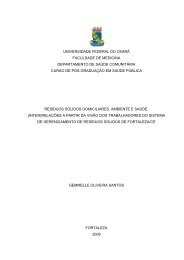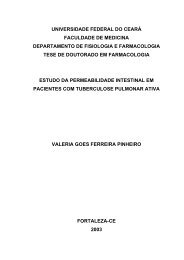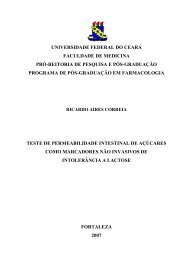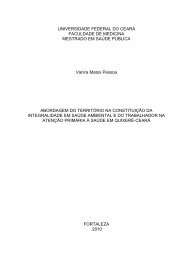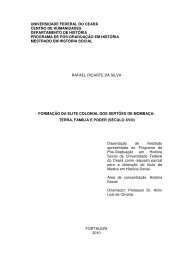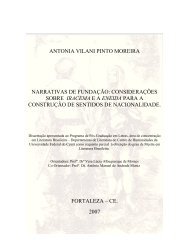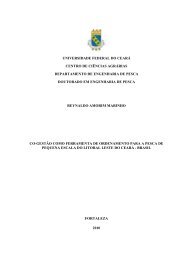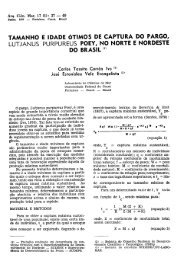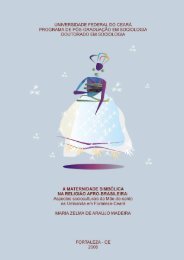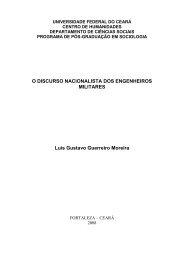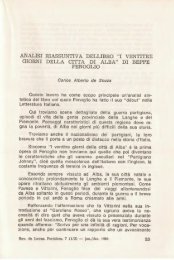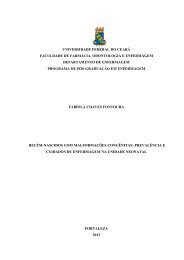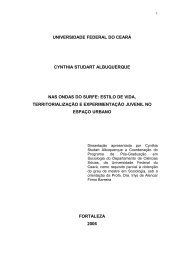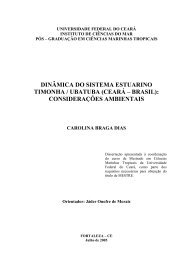Tungíase: doença negligenciada causando patologia grave
Tungíase: doença negligenciada causando patologia grave
Tungíase: doença negligenciada causando patologia grave
You also want an ePaper? Increase the reach of your titles
YUMPU automatically turns print PDFs into web optimized ePapers that Google loves.
Heukelbach et al – Tungiasis in Alagoas State, Brazil<br />
performed a population-based study on tungiasis<br />
in a rural community in Alagoas.<br />
Materials and Methods<br />
Study Area and Population<br />
Alagoas is the second smallest state of Brazil,<br />
situated in the northeast of the country, with a<br />
population of about 3 million. The economy of the<br />
state is based on agriculture, mainly sugar cane<br />
and coconut plantations, as well as fishing. The<br />
climate of Alagoas is tropical with intense rainfalls<br />
from April to August. During this period, 70% of the<br />
annual precipitation of 2,000 mm occurs. The<br />
average daily temperature is 26.6°C in the dry<br />
season and 25.1°C in the rainy season.<br />
The study was carried out in Feliz Deserto, a<br />
typical village situated approximately 120 km south<br />
of Maceió, the capital of Alagoas. It is located at<br />
the coast and has a total population of 3,850<br />
inhabitants.<br />
The study area was defined as those districts<br />
of Feliz Deserto, where tungiasis commonly had<br />
occurred in the past (according to local health<br />
personnel, community leaders, and our own<br />
observations). A cohort of 1,250 individuals, about<br />
one third of the total population of the municipality,<br />
was involved in the study. Living conditions in<br />
these districts were more precarious than in the<br />
other areas of town.<br />
Study Design<br />
Two cross-sectional surveys were done: all<br />
households in the study area were visited in<br />
June/July 2003 (rainy season), and a second time<br />
in October/November 2003 (dry season). To be<br />
included in the study, individuals were required to<br />
spend at least four nights per week in a household<br />
in the study area. Anyone refusing to take part in<br />
the study was excluded. Individuals moving into<br />
the study area between the surveys were<br />
registered and took part in the second survey.<br />
All household members were examined<br />
clinically for the presence of tungiasis. Numbers of<br />
lesions and associated pathology were<br />
documented on standardized questionnaires.<br />
Additionally, household members were interviewed<br />
to obtain socio-demographic and clinical data. If a<br />
household member was absent, the household<br />
was revisited three times. For some household<br />
members an appointment was made at work or at<br />
!<br />
"!#$%&'(!)&*&+,-.$/!0,1$(2.&3!"##$%!&'"()!"#"*"#+,<br />
home. Each survey was carried out within a period<br />
of two months.<br />
To reduce inter-observer bias, all clinical<br />
examinations were carried out by one investigator<br />
(A.J.).<br />
Clinical Examination and Questionnaires<br />
For the clinical examination, the head of the<br />
household was asked for a room with good light<br />
and in which privacy was guaranteed. In this room,<br />
the body was thoroughly examined for the<br />
presence of tungiasis.<br />
Tungiasis was diagnosed if at least one<br />
embedded sand flea was present. Lesions were<br />
classified according to the Fortaleza classification<br />
[20]: a penetrating flea (stage I); an itching,<br />
reddish-brown spot with a diameter of one to three<br />
mm indicating the complete penetration of the flea<br />
into the epidermis (stage II); and a circular lesion<br />
presenting as a white patch with a central black<br />
dot and a diameter of four to ten mm indicating the<br />
maturity of the egg-expelling flea (stage III) are<br />
defined as viable lesions. Lesions with a black<br />
crust surrounded by necrotic tissue (stage IV), as<br />
well as partially or totally removed fleas leaving a<br />
characteristic sore in the skin are defined as<br />
nonviable tungiasis, i.e. the parasite is dead.<br />
Lesions were counted and the topographic<br />
localization was documented on a visual record<br />
sheet.<br />
According to Muehlen et al. [21] and<br />
Ugbomoiko et al. [22], a mild infestation was<br />
defined as the presence of 1 to 5, a moderate<br />
infestation as the presence of 6 to 30, and heavy<br />
infestation as the presence of >30 lesions.<br />
Symptoms and signs associated with acute or<br />
chronic tungiasis were noted as previously defined<br />
[23]. Superinfection was diagnosed when pustules<br />
or suppuration were present. Socio-demographic<br />
data were assessed using pre-tested structured<br />
questionnaires.<br />
Data Entry and Statistical Analysis<br />
Data were entered twice into a database using<br />
the Epi Info software package (version 6.04d;<br />
Centers for Disease Control and Prevention,<br />
Atlanta, USA) and checked for entry errors. Then,<br />
data were transferred to Stata® software package<br />
(version 9.0; Stata Corporation, College Station,<br />
USA) for analysis. The Fisher's exact test was<br />
applied to determine the significance of differences<br />
203



